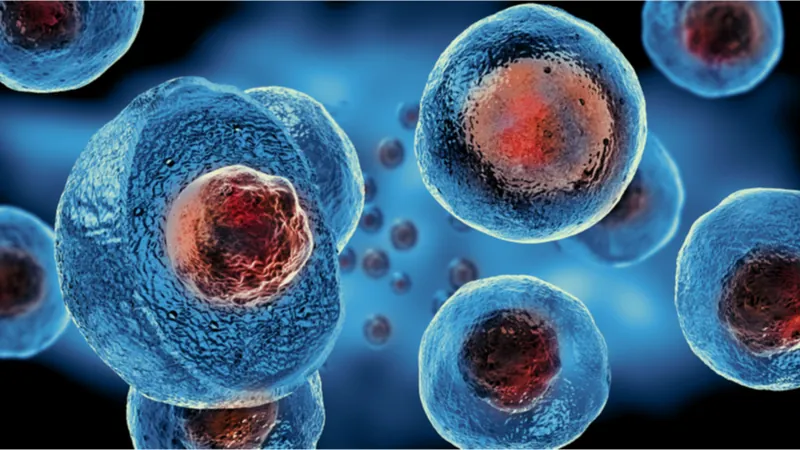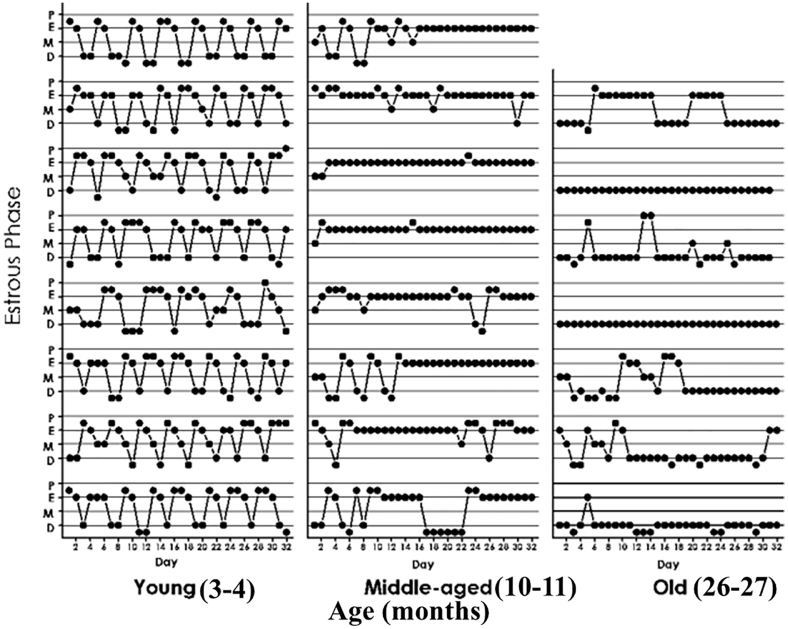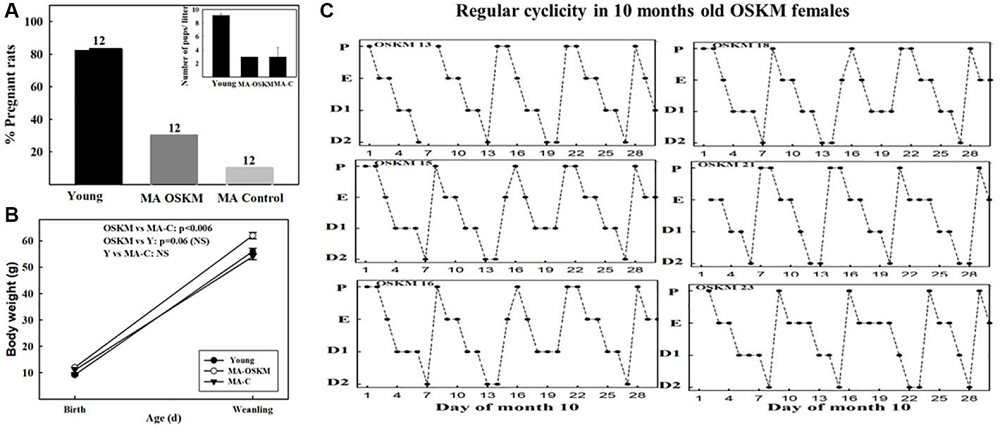The authors of a recent study reported that OSKM/Yamanaka factor gene therapy in rats results in higher fertility at an older age compared to controls and allows older rats to have regular cycles [1].
Rejuvenating Yamanaka factors

Read More
Multiple studies have suggested that gene therapy that uses the Yamanaka factors has profound regenerative and lifespan-extending potential. For example, David Sinclair’s lab has reversed glaucoma in mice using three of the four factors.
Based on this evidence, the authors of this paper designed a gene therapy that used an adenovirus to carry these four factors. The researchers chose the hypothalamus, a brain structure that is a part of the hypothalamic-pituitary-gonadal axis and is essential for many functions, including reproduction [2]. The goal of this long-term gene therapy was to slow down fertility decline.
Decreasing reproductive capacity
A human female’s reproductive system ages and fails to function correctly much earlier than other systems, with females spending a significant portion of their lives in the post-menopausal stage. A female rat’s reproductive capacity decreases in middle age, and hormonal changes lead to changes in estrous cyclicity, which is the rat’s equivalent of the menstrual cycle [3, 4].
This group of researchers had previously demonstrated that insulin-like growth factor-I (IGF-I) gene therapy, targeted to the hypothalamus and started at 8 months of age, could extend rats’ regular cycles beyond the age of 10 months, which is when untreated rats’ cycles become irregular. At 11 months, treatment with that gene therapy also “preserves the integrity of ovarian structure.” In contrast, age-matched controls mostly didn’t have cycles, and a high percentage had polycystic ovaries [5].
Extended regular cycles
In this study, the researchers used female Sprague-Dawley rats and divided them into groups of 12 animals each. At four months of age, they injected an specifically modified virus (adenoviral vector) carrying either OSKM and green fluorescent protein (GFP) genes or only GFP as a control into the rodents’ hypothalami, spurring the production of proteins. Then, they observed how the rat’s cycles changed as the animals aged.
The control group of rats had the typical age-related changes to their estrous cycles. The young rats had regular estrous cycles, which last for 4-5 days and have four stages: proestrus, estrus, metestrus, and diestrus.
This regularity changed around 9 months of age, when cycles became more irregular. Starting at 10 months of age, the researchers observed the prevalence of constant estrus status and the presence of numerous fluid-filled sacs (follicular cysts) in the ovaries. Past 20 months of age, female rats transitioned into the constant diestrus phase.

OSKM treatment impacted these cycles, and the OSKM-treated animals continued to have regular cycles at 10 months old.
Impact on fertility
The animals were mated for one week with a young male rat. The mating occurred almost half a year after the gene therapy. The authors point out that even though gene expression should still occur, the expression levels are most likely lower at the time of mating compared to the time of injection.
The researchers also admit that they expected viral vectors carrying OSKM to reach only a small proportion of hypothalamic cells. However, this was enough to impact the rate of reproductive aging.
The young group had the highest pregnancy rate at 83%, and the old control group had almost exactly a tenth of that, at 8.3%. The OSKM-treated group had a pregnancy rate of 25%, which, while lower than that of the young group, was still improved compared to the age-matched control group. However, it was not statistically significantly different (p=0.06552). An increase in the size of the experimental cohort would be beneficial in obtaining statistically significant and more robust experimental proof, but these results show a very positive trend.
The younger group also had a larger litter size (mean litter size 9.1 pups), while the mean litter size of the older animals, both control and OSKM-treated, was three pups. Pups from all groups survived and showed normal behavior.
The researchers observed differences in body weight at birth. It was lower for pups born to young mothers but similar in both groups of older mothers. However, there were differences between the pups from the older mothers at the time of weaning. The pups from the OSKM-treated animals gained more weight than the old control animals’ pups, suggesting that age affects milk supply. However, OSKM treatment can remedy the lack of milk supply and/or increase milk quality.
The weight of the pups from younger mothers remained lower, which was possibly caused by the larger litter size and more animals that the mother needed to feed.

A long road to optimizing fertility
The researchers believe that achieving regular cycles, and a 25% fertility rate in rats that are close to the cessation of their reproductive span, shows that this OSKM gene therapy significantly benefited the animals’ reproductive system; however, the fertility rate was lower than in young animals, suggesting that “regular ovulation is a necessary but not sufficient condition for keeping the rats at optimal fertility levels.” There are also other components of the reproductive system that impact fertility.
The researchers of this study were unable to assess any changes in hypothalamic DNA methylation following OSKM gene therapy. However, they expect that, as in previous work, OSKM treatment led to the reversal of age-related epigenetic changes.
The researchers suggest that this kind of therapy might be used to help extend women’s reproductive span. However, given that this research was done in rats, the impact and side effects of such a therapy on human beings need to be extensively studied in the future.
Literature
[1] Gallardo, M. D., Girard, M., Portiansky, E. L., & Goya, R. G. (2025). Oct4, Sox2, Klf4, c-My (OSKM) gene therapy in the hypothalamus prolongs fertility and ovulation in female rats. Aging, null, 10.18632/aging.206191. Advance online publication.
[2] Neal-Perry, G., Nejat, E., & Dicken, C. (2010). The neuroendocrine physiology of female reproductive aging: An update. Maturitas, 67(1), 34–38.
[3] Neal-Perry, G. S., Zeevalk, G. D., Santoro, N. F., & Etgen, A. M. (2005). Attenuation of preoptic area glutamate release correlates with reduced luteinizing hormone secretion in middle-aged female rats. Endocrinology, 146(10), 4331–4339.
[4] Huang, H. H., Marshall, S., & Meites, J. (1976). Capacity of old versus young female rats to secrete LH, FSH and prolactin. Biology of reproduction, 14(5), 538–543.
[5] Rodríguez, S. S., Schwerdt, J. I., Barbeito, C. G., Flamini, M. A., Han, Y., Bohn, M. C., & Goya, R. G. (2013). Hypothalamic IGF-I gene therapy prolongs estrous cyclicity and protects ovarian structure in middle-aged female rats. Endocrinology, 154(6), 2166–2173.








































